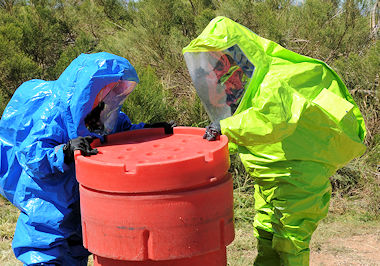Handling Drums and Containers
Accidents may occur during handling of drums and other hazardous waste containers.
Hazards include detonations, fires, explosions, vapor generation, and physical injury resulting from moving heavy containers by hand and working around stacked drums, heavy equipment, and deteriorated drums.
While these hazards are always present, proper work practices, such as minimizing handling and using equipment and procedures that isolate workers from hazardous substances, can minimize the risks to site personnel.
Hazardous substances and contaminated, liquids and other residues must be handled, transported, labeled, and disposed of properly. Drums and containers used during the clean-up must meet the appropriate DOT, OSHA, and EPA regulations for the wastes that they contain.
Identifying Contents of Drums and Containers
Appropriate procedures for handling drums varies depending on the drum contents. Prior to handling, drums should be inspected visually to identify their contents. Information that may be helpful includes:
- symbols, words, or other marks on the drum indicating that its contents are hazardous,
- symbols, words, or other marks indicating that the drum contains discarded laboratory chemicals, reagents, or other potentially dangerous materials in small-volume individual containers,
- signs of deterioration such as corrosion, rust, and leaks, and
- configuration of the drumhead (For example, if the whole lid of the drum can be removed, then it was designed to contain solid material; if the lid has a bung, then the drum was intended for liquids. If the drumhead contains a liner, the drum may likely contain highly corrosive or otherwise hazardous materials.)
Noting the type of drum also may be useful for identifying potential hazards:
- Polyethylene or PVC-lined drums often contain strong acids or bases.
- If the lining is punctured, the substance usually quickly corrodes the steel, and may cause a significant leak or spill.
- Exotic metal drums (e.g., aluminum, nickel, stainless steel) are very strong and expensive, and are often used to store extremely dangerous materials.
- Single-walled drums used as a pressure vessel have fittings for both the storage product and for an inert gas. These drums may contain reactive, flammable, or explosive substances.
Conditions in the immediate vicinity of the drums may provide information about drum contents and associated hazards. Air monitoring should be conducted around the drums. If buried drums are suspected, ground-penetrating systems can be used to estimate the location and depth of the drums.
Knowledge Check Choose the best answer for the question.
3-1. While inspecting a drum, you notice the whole lid of the drum may be removed. What does this indicate?
You forgot to answer the question!

